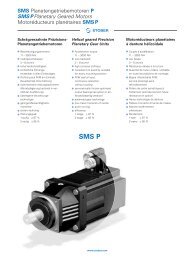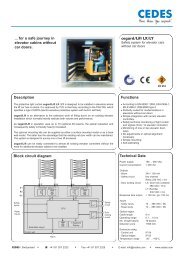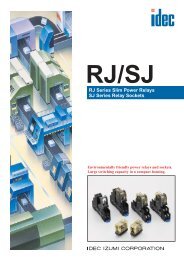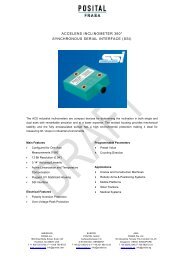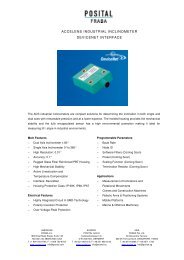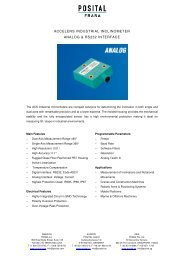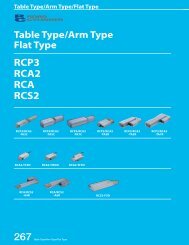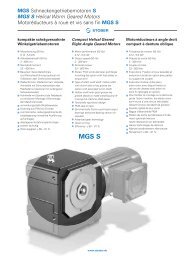Create successful ePaper yourself
Turn your PDF publications into a flip-book with our unique Google optimized e-Paper software.
<strong>HS6E</strong> Subminiature Interlock Switches with Solenoid<br />
When using the HS9Z-A65/HS9Z-A66 Angle Adjustable<br />
Actuator<br />
• When the door hinge is on the extension line of the interlock<br />
switch surface<br />
Horizontal Adjustment<br />
HS9Z-A65<br />
HS9Z-A66<br />
Minimum<br />
Radius<br />
50 mm<br />
50 mm<br />
Minimum<br />
Radius<br />
• When the door hinge is on the extension line of the actuator<br />
mounting surface<br />
Horizontal Adjustment<br />
HS9Z-A65<br />
HS9Z-A66<br />
70 mm<br />
70 mm<br />
Minimum Radius<br />
Minimum<br />
Radius<br />
Door Hinge<br />
Door Hinge<br />
Door Hinge<br />
Door Hinge<br />
Actuator Angle Adjustment for the HS9Z-A65/HS9Z-A66<br />
• Using the angle adjustment screw, the actuator angle can be<br />
adjusted (see figures on page 10).<br />
Adjustable angle: 0 to 20°<br />
• The larger the adjusted angle of the actuator, the smaller the<br />
applicable radius of the door opening.<br />
• After installing the actuator, open the door. Then adjust the<br />
actuator so that its edge can enter properly into the actuator<br />
entry slot of the interlock switch.<br />
• After adjusting the actuator angle, apply Loctite to the<br />
adjustment screw so that the screw will not become loose.<br />
Mounting Examples<br />
Application on Sliding Doors<br />
Door<br />
Vertical Adjustment<br />
HS9Z-A65<br />
HS9Z-A66<br />
HS9Z-A65<br />
HS9Z-A66<br />
HS9Z-A61 Actuator<br />
Minimum<br />
Radius<br />
50 mm<br />
50 mm<br />
Minimum<br />
Radius<br />
Vertical Adjustment<br />
70mm<br />
70mm<br />
Minimum Radius<br />
Minimum<br />
Radius<br />
Door Hinge<br />
Label<br />
Door Hinge<br />
Door Hinge<br />
Label<br />
Door Hinge<br />
Application on Hinged Doors<br />
HS9Z-A62S Actuator<br />
For Manual Unlocking<br />
Spring lock type<br />
The <strong>HS6E</strong> allows manual unlocking of the actuator to pre-check<br />
proper door operation before wiring or turning power on, as well as<br />
for emergency use such as a power failure.<br />
Solenoid lock type<br />
The <strong>HS6E</strong> can be unlocked manually in emergency.<br />
When using the manual unlock key<br />
UNLOCK<br />
LOCK<br />
Manual Unlocking<br />
(installed on both sides)<br />
Normal Position<br />
Manual Unlocking<br />
Position<br />
• When locking or unlocking the interlock switch manually, turn<br />
the key fully using the manual unlocking key supplied with the<br />
switch.<br />
• Using the interlock switch with the key not fully turned (less<br />
than 90°) may cause damage to the switch or operation<br />
failures (when manually unlocked, the switch will keep the<br />
main circuit disconnected and the door unlocked).<br />
• Do not apply excessive force (0.45 N·m or more) to the<br />
manual unlock part, otherwise the manual unlock part will<br />
become damaged.<br />
• Do not leave the manual unlocking key attached to the switch<br />
during operation. This is dangerous because the switch can<br />
always be unlocked while the machine is in operation.<br />
Manual Unlock Key<br />
(supplied with the switch)<br />
When unlocking pushing the plate inside the interlock switch<br />
• Remove the screw at the side of the interlock switch (the same<br />
side where actuator is inserted) and insert a small screwdriver.<br />
• Push the plate inside the interlock switch toward the LED<br />
indicator using the screwdriver until the actuator is unlocked.<br />
• Tighten the screw to a proper torque (0.3 to 0.5 N·m). Do not<br />
tighten with excessive force, otherwise the interlock switch will<br />
be damaged. Be sure to reinstall the screw, otherwise the<br />
waterproof capability will be lost.<br />
<strong>HS6E</strong><br />
Interlock Switch<br />
Latch<br />
Door Stop<br />
Note: When mounting an actuator, make sure<br />
that the actuator enters the slot in the<br />
correct direction, as shown on the right.<br />
Screwdriver<br />
Caution<br />
Before manually unlocking the interlock switch, make sure<br />
that the machine has come to a complete stop. Manual<br />
unlocking during operation may unlock the interlock switch<br />
before the machine stops, and the function of the interlock<br />
switch with solenoid is lost. While the solenoid is energized,<br />
do not unlock the switch manually (solenoid lock type).<br />
14<br />
(07/03/16)




